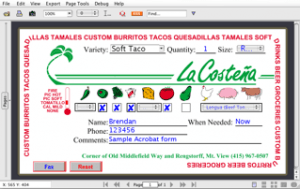Interactive Forms in PDF Files
PDF files can include interactive forms – radio buttons, checkboxes, text boxes, lists, etc. There are interactive widgets – the user can click on the and change the values. So you can use PDF files for everything from your tax returns to ordering pizza.
How Form Data Is Stored
The data for forms is stored in a separate area to the text on the page (which coincidentally makes it much easier to edit and extract). Forms flattening is the process of removing this separate form data and adding it as text, images and shapes into the actual PDF data stream.
The PDF will still look the same but the user can no longer interact with the forms. You can also extract flattened form data from a PDF file.
Typical Use Cases
- Submitting finalized forms (such as tax returns or legal agreements) to prevent future alteration.
- Archiving completed forms as permanent records.
- Distributing documents where preserving the exact layout and preventing field modification is required.
Reasons for Flattening Forms
There are several good reasons for PDF Form flattening:
1. It stops the form values being editable and easily changed.
2. It removes the other values on lists and drop down boxes.
3. It simplifies the PDF (and will generally make it faster to render).
Disadvantages
The one disadvantage is that it makes it much harder to extract or alter the form data – that checkbox is now just a special character on the page. So keep the originals just incase.
FormVu allows you to
| Use Interactive PDF Forms in the Web Browser |
| Integrate fillable PDF Forms into Web Apps |
| Parse PDF forms as HTML5 |
What is FormVu?
FormVu is a commercial SDK for converting PDF Form files into standalone HTML with interactive form components.
Why use FormVu?
FormVu allows you to integrate PDF forms into your web application effortlessly while retaining all their interaction and functionality.
What licenses are available?
We have 3 licenses available:
Cloud for form conversion using the shared IDRsolutions cloud server, Self hosted server option for your own cloud or on-premise servers, and Enterprise for more demanding requirements.
How to use FormVu?
Want to learn more about FormVu and how to use it, we have plenty of tutorials and guides to help you.
